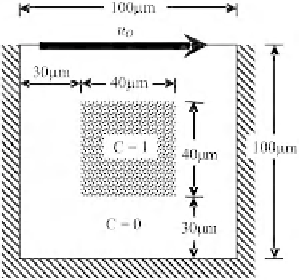Biomedical Engineering Reference
In-Depth Information
FIGURE 3.16
Schematic of a mixing process in a lid-driven microcavity.
lid and the three walls of the cavity are impermeable to the transport of species X, the zero-flux
condition is applied at these boundaries. For the Navier-Stokes equations, the properties of water are
used, i.e.,
m¼
10
3
Pa s and
r ¼
1000 kg/m
3
. No-slip condition is enforced at the lid and the three
walls. The velocity
u
u
o
is given at the lid as the boundary condition. The concentration of species X
and the fluid velocity are shown in
Fig. 3.17
. The effect of the velocity field on the concentration
distribution of species X is dominant.
¼
3.6.3
Mixing in a straight microchannel
Figure 3.18
shows a straight microchannel. Water flows into the microchannel at the inlet carrying
a nonuniform concentration of species X. Mixing of species X then occurs in the microchannel. This
problem is governed by the species conservation (Eqn
3.1
) and the Navier-Stokes (Eqns
3.3 and 3.4
)
equations. The diffusion coefficient is set to
D
10
9
m
2
/s. For species X, at the inlet, the
concentration of species X is nonzero only at the upper half of the microchannel. The zero-flux
condition is applied at both the upper and lower walls. At the outlet, zero-gradient condition is
enforced. For the Navier-Stokes equations,
¼
the properties of water are used. A velocity of
u
o
¼
0.01 m/s is set at the inlet. No-slip condition is enforced at the walls. Outflow boundary
condition is used at the outlet. A steady-state solution is sought.
Figure 3.19
shows the steady-state
concentration distribution in the microchannel. The results show that species X diffuses into the fluid
in the lower half of the microchannel.
3.6.4
Mixing in winding microchannels
The same mixing problem of Section
3.6.3
is considered for two different winding microchannels.
These are a double-bend microchannel and a serpentine microchannel, depicted respectively in
Figs. 3.20 and 3.21
. The steady-state concentration distributions are shown in these figures. In
terms of compactness, the serpentine microchannel offers more turnings to enhance mixing of
species X. In this configuration, species X is considered homogenously mixed after the third
'U' turns.




Search WWH ::

Custom Search